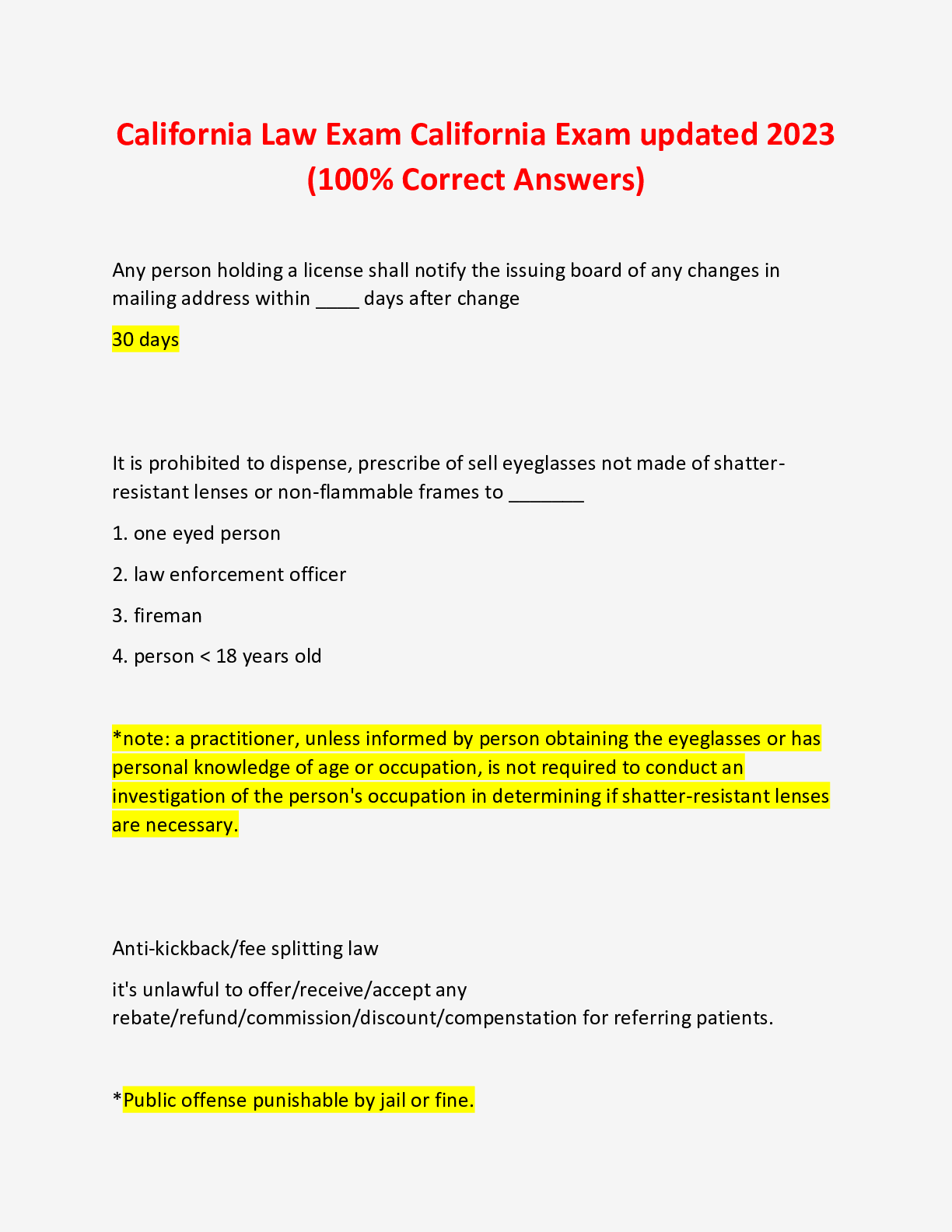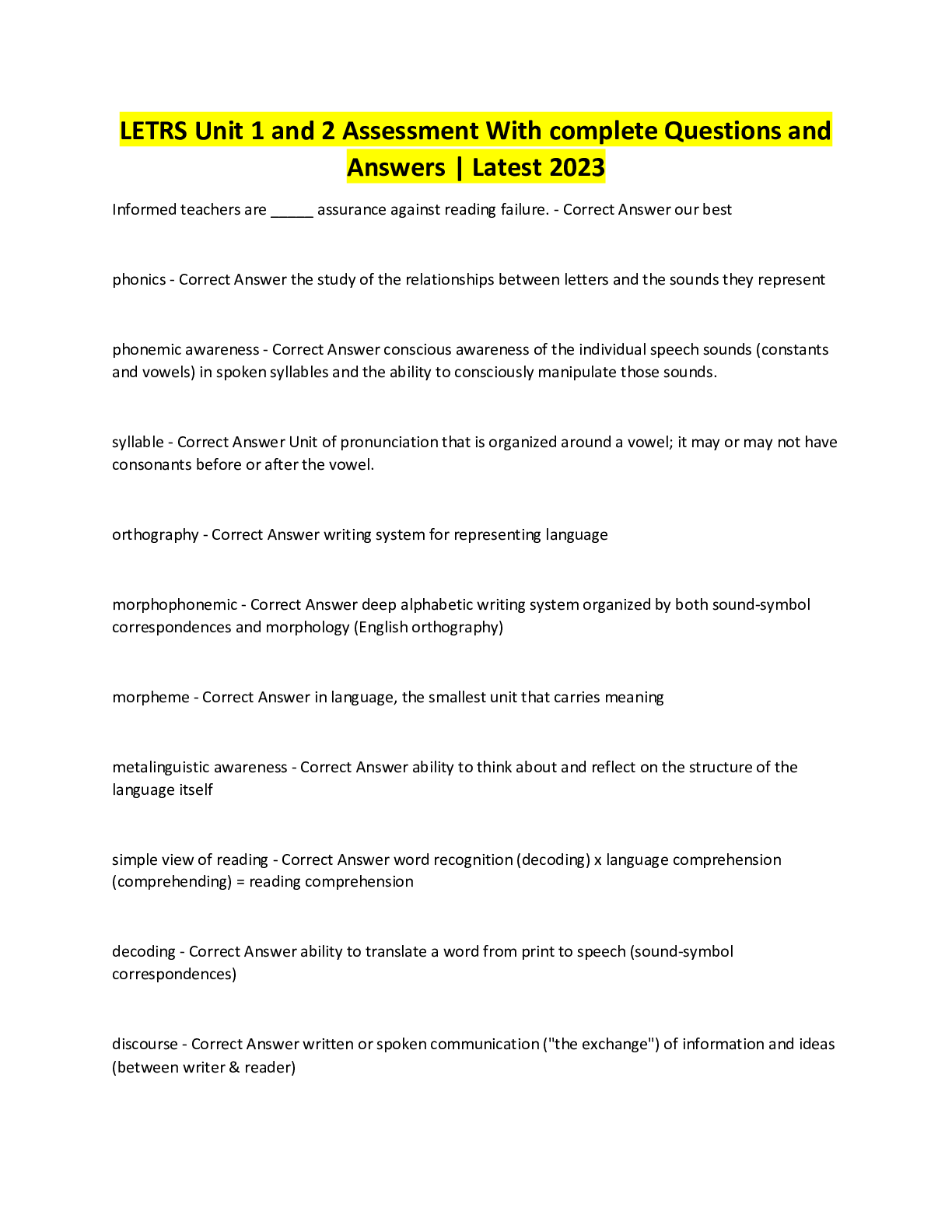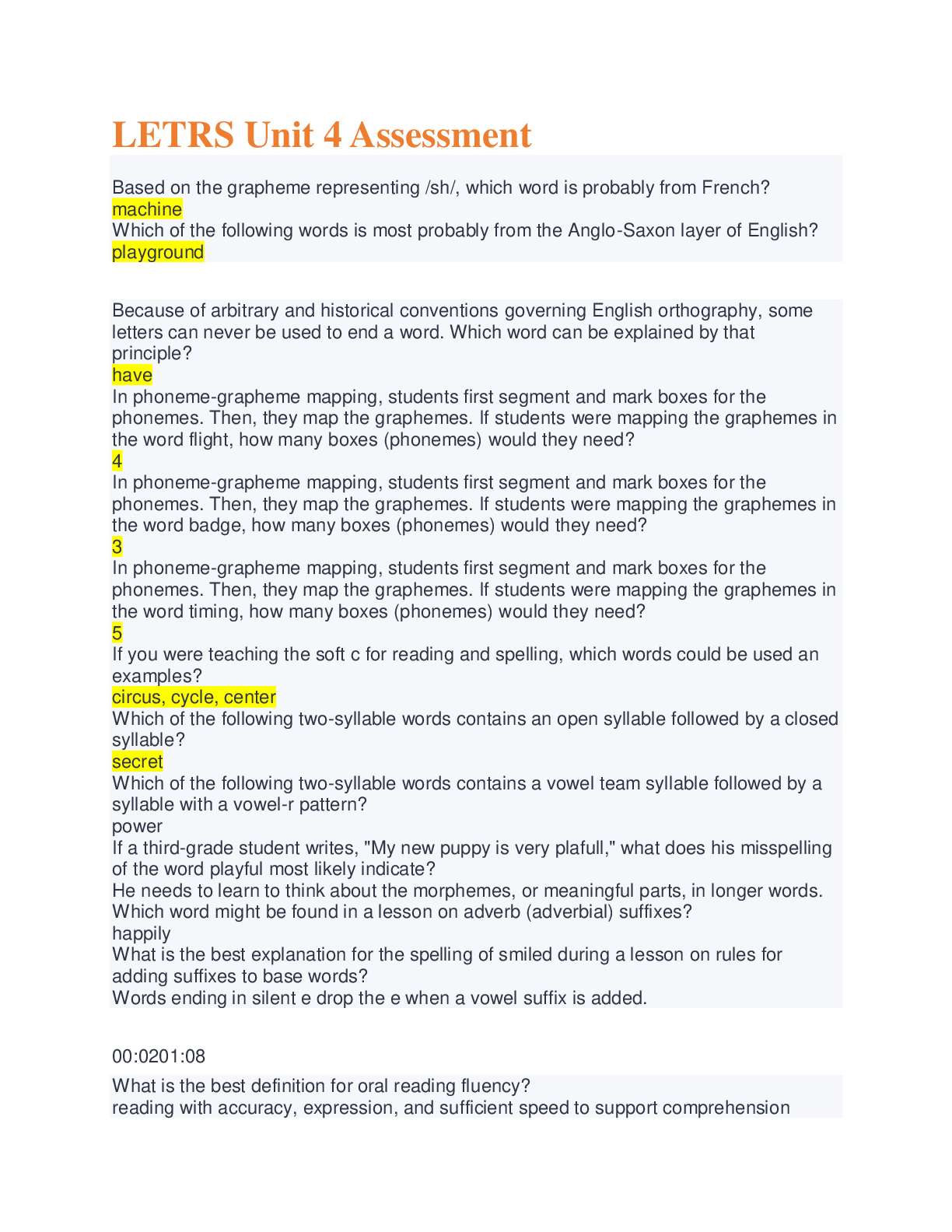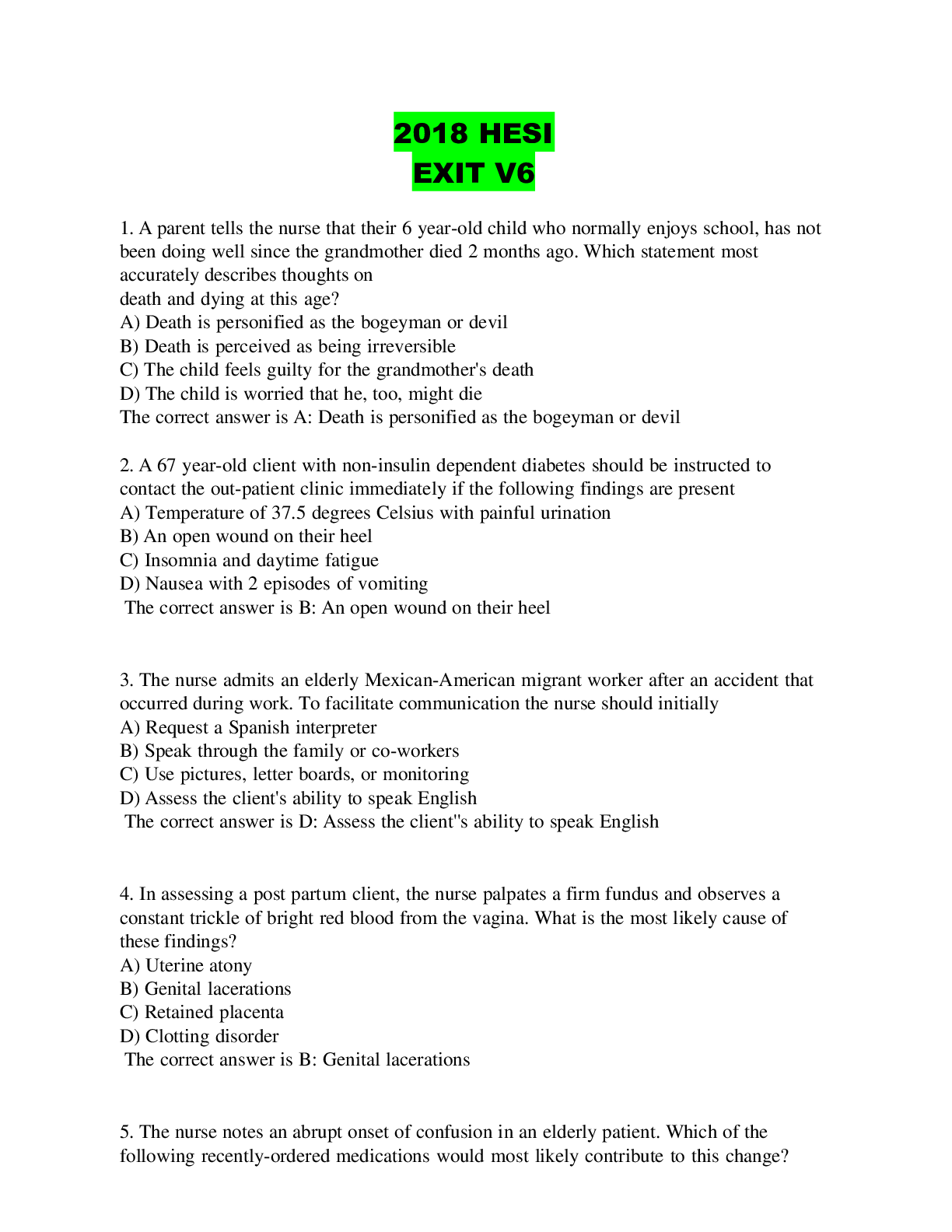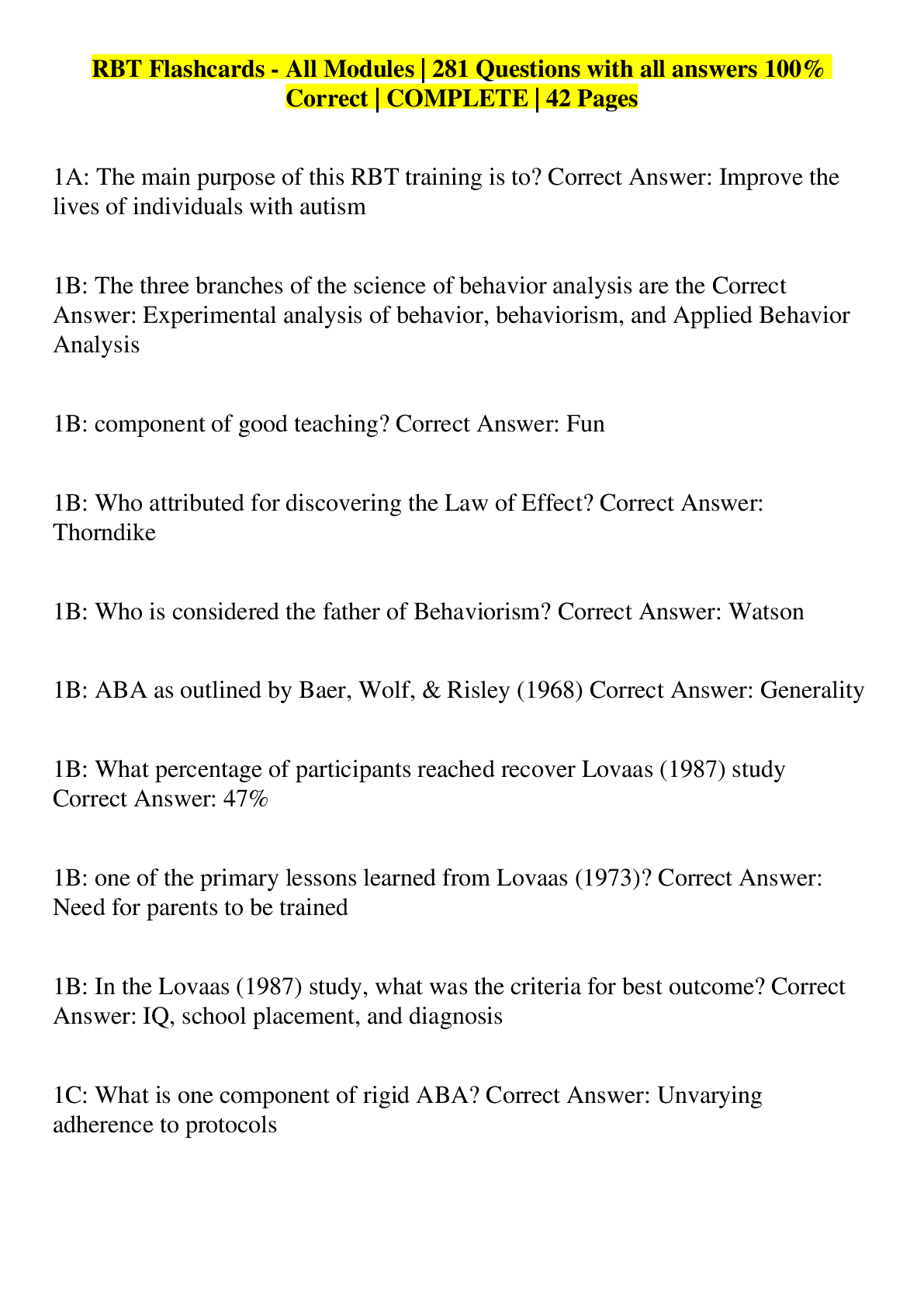Emergeny Medicine > EXAM > EMT FISDAP READINESS EXAM 2 QUESTIONS AND ANSWERS (2022/2023) (Verified Answers) (All)
EMT FISDAP READINESS EXAM 2 QUESTIONS AND ANSWERS (2022/2023) (Verified Answers)
Document Content and Description Below
EMT FISDAP READINESS EXAM 2 QUESTIONS AND ANSWERS (LATEST 2022/2023) The collective set of regulations and ethical considerations governing the EMT is called: A. Duty of act B. Scope of... practice C. Advance directives D. Good Samaritan law -answer- B Legislation that governs the skills and medical interventions that may be performed by an EMT is: A. Standardized (uniform) throughout the country B. Different from state to state C. Standardized (uniform) for regions within a state D. Governed by the US Department of Transportation -answer- B When the EMT-B makes the physical/emotional needs of the patient a priority, this is considered a of the EMT. A. Advance directive B. Protocol C. Ethical Responsibility D. Legal Responsibility -answer- C Which one of the following is not a type of consent required for any treatment or action by an EMT? A. Child and mentally incompetent adult B. Implied C. Applied D. Expressed -answer- C When you inform the adult patient of a procedure you are about to perform and its associated risks, you are asking for her or his: A. Expressed consent B. Negligence C. Implied consent D. Applied consent -answer- A You are treating a patient who was found unconscious at the bottom of a stairwell. Consent that is based on the assumption that an unconscious patient would approve the EMT's life-saving interventions is called: A. Expressed B. Negligence C. Implied D. Applied -answer- C Your record of a patients refusal of medical care (aid) or transport should include all of the following except: A. Informing the patient of the risks and consequences of refusal B. Documenting the steps you took C. Signing of the form by the Medical Director D. Obtaining a release form with the patient's witnessed signature -answer- C Forcing a competent adult patient to go to the hospital against his or her will may result in charges against the EMT. A. Abandonment B. Assault and battery C. Implied consent D. Negligence -answer- B Which one of the following is an action you should not take if a patient refuses care? A. Leave phone stickers with emergency numbers B. Recommend that a relative call the daily physician to report the incident C. Tell the patient to call his or her family physician if the problem reoccurs D. Call a relative or neighbor who can stay with the patient -answer- C Another name for DNR is: A. Deviated nervous response B. Duty not to react C. Refusal of treatment D. Advance directive -answer- D There are varying degrees of DNR orders, expressed through a variety of detailed instructions that may be part of the order, such as: A. Allowing CPR only if cardiac or respiratory arrest was observed. B. Allowing comfort-care measures such as intravenous feeding C. Disallowing the use of long term life-support measures D. Specifying that only 5 minutes of artificial respiration will be attempted -answer- A In a hospital, long-term life-support and comfort-care measures would consist of intravenous feeding and: A. Routine inoculations B. The use of a respirator C. Infection control by the health care providers D. Hourly patient documentation -answer- B If an EMT with a duty to act fails to provide the standard of care, and if this failure causes harm or injury to the patient, the EMT may be accused of: A. Res ipsa loquitur B. Negligence C. Abandonment D. Assault -answer- B Leaving a patient in the hallway stretcher in a busy ED and leaving without giving a report to a health care professional is an example of: A. Liability infraction B. Battery C. Abandonment D. Breach of duty -answer- C The EMT should not discuss information about a patient except to relay pertinent information to the physician at the emergency department. Information considered confidential includes: A. Patient history gained through interview B. Assessment findings C. Treatment rendered D. All of these -answer- D The EMT can release confidential patient information in all of these following circumstances except to: A. Inform other health care professional who need to know information to continue care B. Report incidents required by state law, such as rape or abuse C. Comply with a legal subpoena D. Protect the other victims of a motor vehicle collision -answer- D A medical identical devise that indicates serious patient medical conditions comes in the form of each of the following except: A. Bracelets B. Necklaces C. Cards D. Patches -answer- D You responded to a high-speed collision involving a motorcycle and an automobile. The 22 year-old male cyclist has severe head injuries and is not likely to live through the evening. When treating this critical patient, who happens to have an organ donor card, the EMT should: A. Transport without delay and document a DNR B. Treat the patient the same as any other patient and inform the ED physician C. Withhold oxygen therapy from the patient to keep the organ hypoxic D. All of these -answer- B You are at the scene of a home invasion where the homeowner was shot to death by the perpetrators. At this crime scene, you should: A. Avoid disturbing any evidence at the scene unless emergency care requires B. Immediately remove the patient from the scene C. Move all obstacles from around the patient to make more room to work D. Search the house for clues to the cause of the crime -answer- A Commonly required reporting situations include all of the following except: A. Child and elder abuse B. Crimes in public places C. Sexual assault D. Domestic abuse -answer- B The extent of limits of the EMT's job is called the: A. Ethical dilemma B. National curriculum C. Scope of practice D. Regional protocol -answer- C You were called to the scene of an incident where a 21 year-old male was knocked unconscious in a bar fight. Upon your arrival, the patient is awake and has a broken nose but no life threats. He admits to drinking six beers in the last hour. He wants to refuse medical attention. Why should you discourage a refusal? A. He is not legally old enough to consent B. He may not be mentally competent at this time C. Patients die from broken noses all the time D. He is unable to actually sign the release -answer- B The federal law designed to protect the patients private medical information is the: A. NHTSA B. ANSI C. HIPAA D. OSHA -answer- C You are on the scene of a call where a patient barricaded himself and his wife in their home and is threatening to do harm. The police have been at the scene for hours and after the wife escaped, they rushed in. It is now your responsibly to transport this now-restrained patient to the local ED. What should be your highest priority? A. Monitoring the patients mental status and vital signs B. Making sure your documentation shows you did not apply handcuffs C. Restraining the patient so he is not able to move D. Explaining to the patient that he no longer has any rights to refuse care -answer- A The police are concerned about the presence of microscopic evidence at the scene of a violent assault. Your crew was asked to be careful and limit their involvement in the scene to essential patient care. What are examples of microscopic evidence? A. The position the patient was initially found in B. Any dirt and carpet fibers C. Fingerprints that were found at the scene D. The condition of the scene -answer- B [Show More]
Last updated: 1 year ago
Preview 1 out of 7 pages

Reviews( 0 )
Document information
Connected school, study & course
About the document
Uploaded On
Jan 19, 2023
Number of pages
7
Written in
Additional information
This document has been written for:
Uploaded
Jan 19, 2023
Downloads
0
Views
82



.png)










